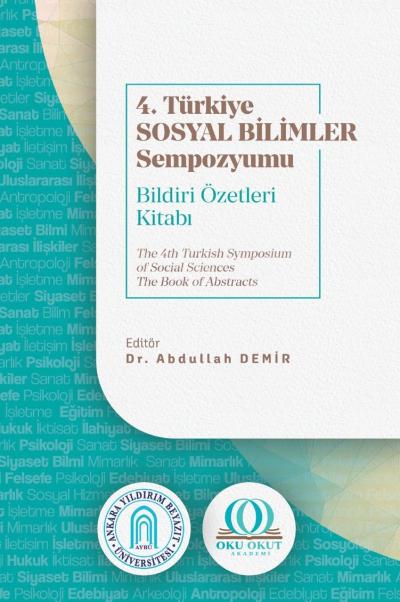Oku Okut Press reserves the right to publish and distribute the book. Permission from the publisher is required for any commercial use.
Hadith Culture in Calendars: Example of the 2022 Diyanet Calendar
Takvimlerde Hadis Kültürü: 2022 Diyanet Takvimi Örneği
Authors
-
Master's Student Emine Arslanhttps://orcid.org/0009-0005-4449-537X
The importance of time and the correct and planned evaluation is beyond all kinds of explanations. The multitude and variety of calendars developed to achieve the perception of time and to plan its flow correctly reflect the historical, cultural, and human accumulation around this subject. The calendar, which means the planning of time, in one sense, of life, is as old as human history, is educational and effective on people/society. Regardless of age, race, gender, color, region, religion, culture, and educational status, the calendar is a necessary and important tool for every person. It must be due to this need that the Turks have used many calendars throughout history, the form and nature of which are different from each other; the twelve-animal calendar, the astrologer (Muneccimbaşı) calendars, the hourly education calendar (Saatli Maarif) are a few examples of this. While calendars plan the flow of work and life on the one hand, they also become a natural and widespread acculturation, learning, and even an important advertising tool on the other. For this reason, many individuals, institutions, and companies who want to promote and spread their own culture, thoughts, and beliefs, become a global brand, and increase their sales have printed and distributed calendars that are suitable for their own purposes and values. Calendars that are used for advertising purposes or to enlighten the public on a certain subject such as health include information about the company's advertisement or the subject that is intended to raise awareness, in addition to the day, month, and year information. Religious content is rarely found in these calendars. However, calendars that contain religious content have many common aspects such as prayer times, religious holidays, special days and nights, sharing of verses and hadiths. These calendars share verses, wise sayings, and hadiths to introduce people to Islamic thought and teachings. The number of hadiths written in the calendar is also quite high. There are some issues to be considered in the sharing of these hadiths, such as reference, authenticity, and context integrity. The Presidency of Religious Affairs also prints calendars that appeal to those who want to know, understand, and live Islam, and naturally includes the hadiths of the Prophet in these calendars. In this notification, after providing general information about calendars especially the content of calendars containing religious content, and the hadith sharing of the calendars, evaluations were made about the authenticity of the hadiths included in the 2022 Diyanet Calendar, the context in which they were processed, and the style of interpretation. The research conducted in previous years and some calendars prepared by other institutions were also pointed out to provide a comparison opportunity. The hypothesis of the research was that the Presidency of Religious Affairs would be meticulous about the authenticity of the hadiths and the references. In general, the hypothesis of the research has been confirmed. However, it was determined that the same success was not fully achieved in the connection of the narrations with the relevant date, subject, and concepts.
Zaman, zamanın doğru ve planlı bir şekilde değerlendirilmesi gibi hususların ehemmiyeti her nevi izahtan varestedir. Vaktin idrakine erişmek ve akışını doğru planlamak için geliştirilen takvimlerin çokluğu ve çeşitliliği bu konu etrafındaki tarihî, kültürel ve insani birikimi yansıtır. Zamanın, bir yönüyle hayatın planlanması anlamına gelen takvim, insanlık tarihi kadar eski ve öğretici ve insan/toplum üzerinde etkilidir. Yaşı, ırkı, cinsiyeti, rengi, bölgesi, dini, kültürü ve eğitim durumu ne olursa olsun her bir insan için takvim gerekli ve önemli bir araçtır. Bu ihtiyaçtan olsa gerektir Türkler de tarih boyunca şekli ve mahiyeti birbirinden farklı pek çok takvim kullanmışlardır; On İki Hayvanlı Takvim, Müneccimbaşı Takvimleri, Saatli Maarif Takvimi buna birkaç örnektir. Takvimler, bir taraftan iş ve hayatın akışını planlarken diğer taraftan da doğal ve yaygın bir kültürlenme, öğrenme hatta önemli bir reklam aracına dönüşür. Bundan dolayıdır ki kendi kültür, düşünce ve inançlarını tanıtmak ve yaymak isteyen, dünya markası haline gelerek satışlarını artırmak isteyen pek çok kişi, kurum ve firma; kendi amaç ve değerlerine uygun takvimler bastırmış ve yaymıştır. Reklam amaçlı ya da halkı sağlık gibi belli bir konuda aydınlatmak isteyen takvimlerde gün, ay ve yıl bilgisinin yanında firma reklamı ya da farkındalık oluşturulmak istenen konuyla ilgili bilgiler bulunur. Bu takvimlerde dinî içeriğe pek rastlanmaz. Oysa muhteviyatında dinî içerik bulunan takvimlerin; namaz vakitleri, dinî bayramlar, özel gün ve geceler, âyet, hadis paylaşımı gibi pek çok ortak yönü vardır. Bu takvimler insanlara İslam düşünce ve öğretisini tanıtmak için âyetler, özlü sözler ve hadisler paylaşmaktadır. Takvimde yazılan hadislerin sayısı da azımsanmayacak kadar fazladır. Bu hadislerin paylaşımında kaynak gösterimi, sıhhat durumunu, bağlam bütünlüğü gibi dikkat edilmesi gereken bazı hususlar vardır. Diyanet İşleri Başkanlığı İslam’ı tanımak, anla(t)mak ve yaşa(t)mak isteyenlere hitap eden takvimler bastırmakta ve doğal olarak bu takvim içerisinde Hz. Peygamber’in hadislerine yer vermektedir. Bu tebliğde takvimler, özellikle dinî içerik barındıran takvimlerin muhteviyatı, takvimlerin hadis paylamışımı hakkında genel bir bilgi verildikten sonra, 2022 yılı Diyanet Takvimi’nde yer alan hadislerin sıhhat durumu, işlendiği bağlam ve yorumlanma tarzı hakkında değerlendirmeler yapılmıştır. Önceki yıllarda yapılan araştırmalara ve diğer kurumlar tarafından hazırlanan kimi takvimlere de işaret edilerek mukayese imkânı sağlanmıştır. Araştırmanın hipotezi Diyanet İşleri Başkanlığı’nın hadislerin sıhhati konusunda ve kaynak gösteriminde titiz olacağı yönündeydi. Genel itibariyle araştırmanın hipotezi doğrulanmıştır. Ancak rivayetlerin tarih, konu ve kavramlarla bağlantıları konusunda aynı başarının tam olarak sağlan(a)madığı tespit edilmiştir.
Copyright
Copyright (c) 2024 Oku Okut Press
ePub License

This work is licensed under a Creative Commons Attribution-NonCommercial 4.0 International License.
Downloads
Publication Information
-
Publication TypeChapter
-
Volume
-
Pages19-22
-
Published24 August 2024
-
Series
-
Series Position6
-
Categories
Arslan, Emine. “Hadith Culture in Calendars: Example of the 2022 Diyanet Calendar”. The 4th Turkish Symposium of Social Sciences: The Books of Abstracts. ed. Abdullah Demir - critical ed . 6/19-22. Social Sciences Proceedings. Ankara: Oku Okut Press, 2024. https://doi.org/10.55709/okuokutyayinlari.291












